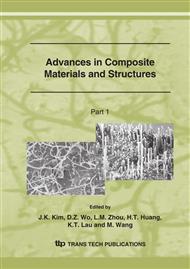p.249
p.253
p.257
p.261
p.265
p.269
p.273
p.277
p.281
Effect of Coupling Agents and Particle Size on Mechanical Performance of Polyethylene Composites Comprising Wollastonite Micro-Fibres
Abstract:
The usefulness of rotational moulding (rotomoulding) as a polymer processing technique is often limited by the selection of polymers, which in most cases happens to be polyethylene (PE). In the present study, PE polyethylene was blended with wollastonite microfibres and maleated polyethylene (as a coupling agent) with the purpose of developing an improved material for rotational moulding. The incorporation of wollastonite fibres without any coupling agent improved the tensile strength, but showed a reduction in impact strength. As expected, the most significant enhancement due to wollastonite was in the tensile modulus.. The addition of a coupling agent improved both the impact strength and the processability, especially when wollastonite was coated with aminosilane. Scanning electron microscopy revealed good adhesion between the coated fibre reinforcement and the polyethylene matrix at the fracture surface.
Info:
Periodical:
Pages:
265-268
Citation:
Online since:
March 2007
Authors:
Price:
Сopyright:
© 2007 Trans Tech Publications Ltd. All Rights Reserved
Share:
Citation:


